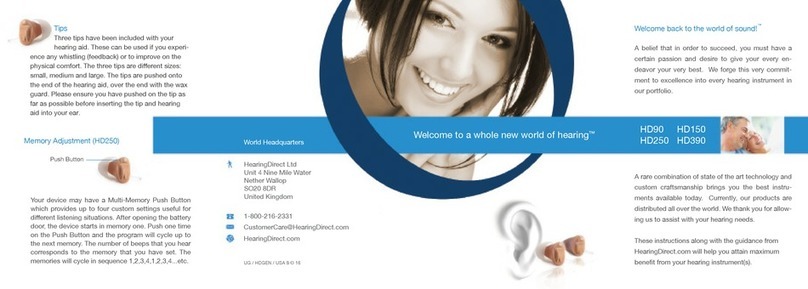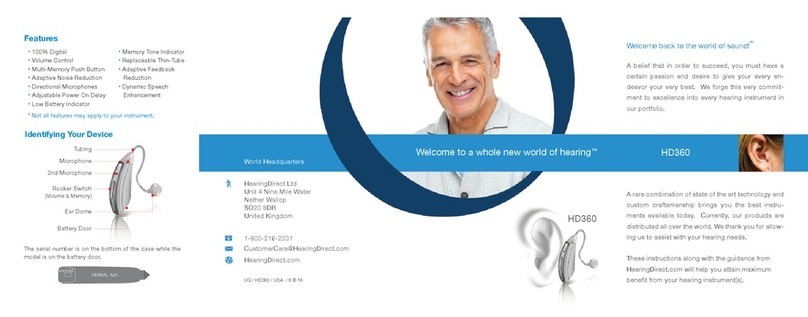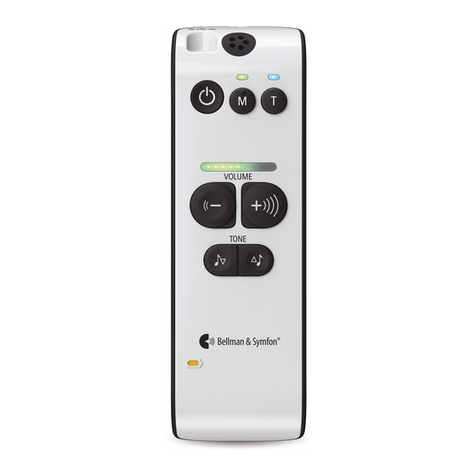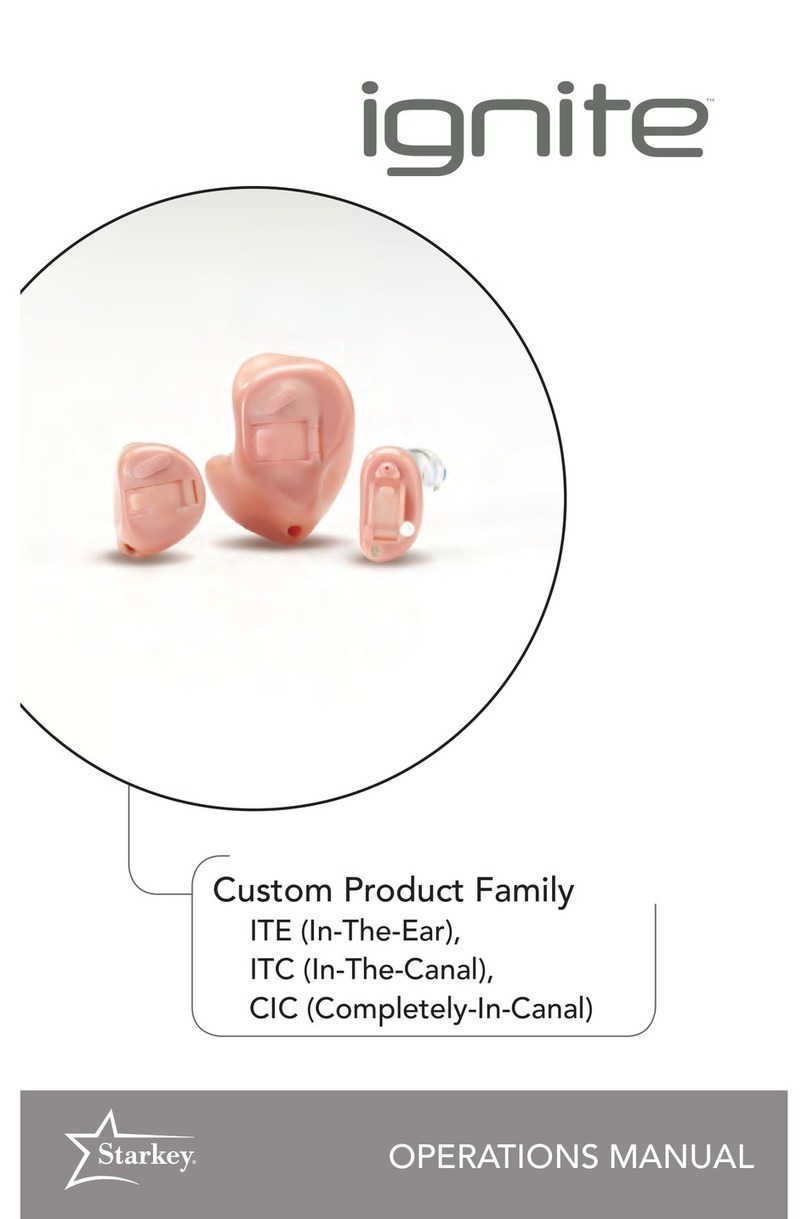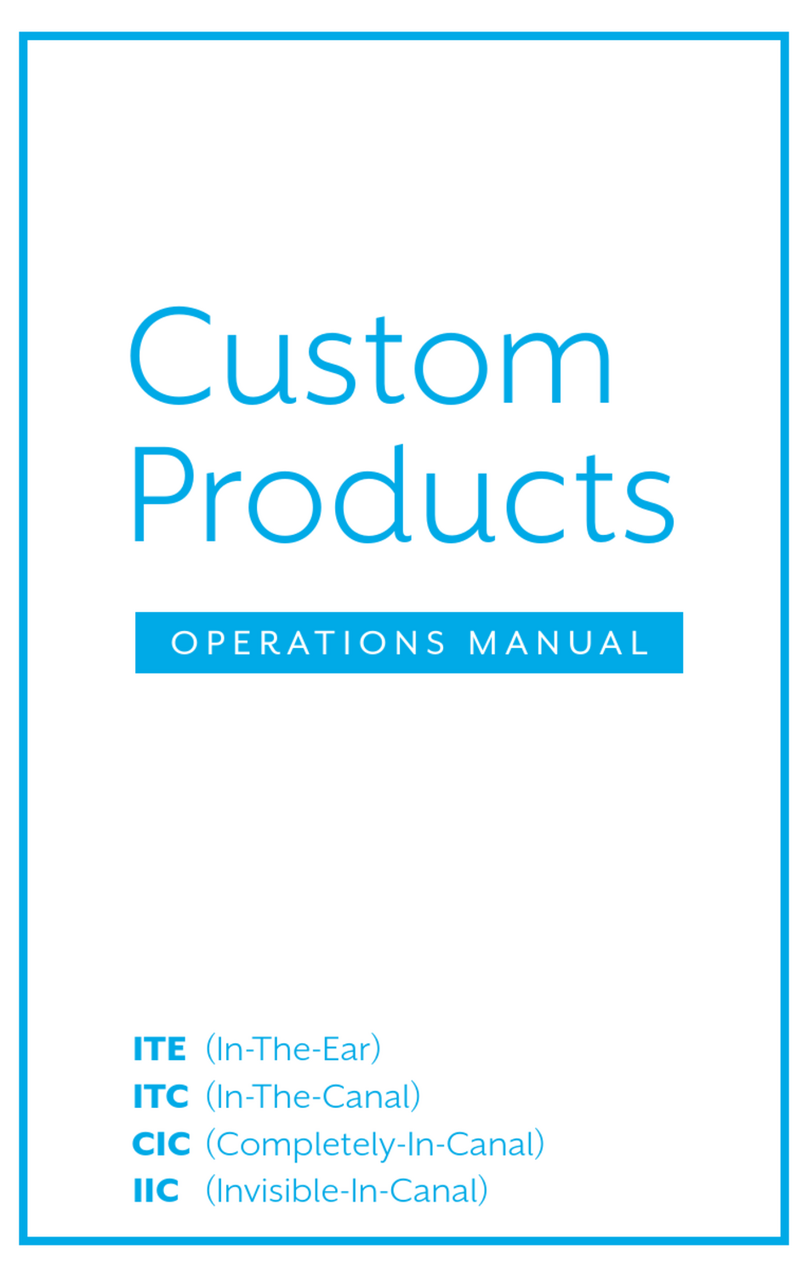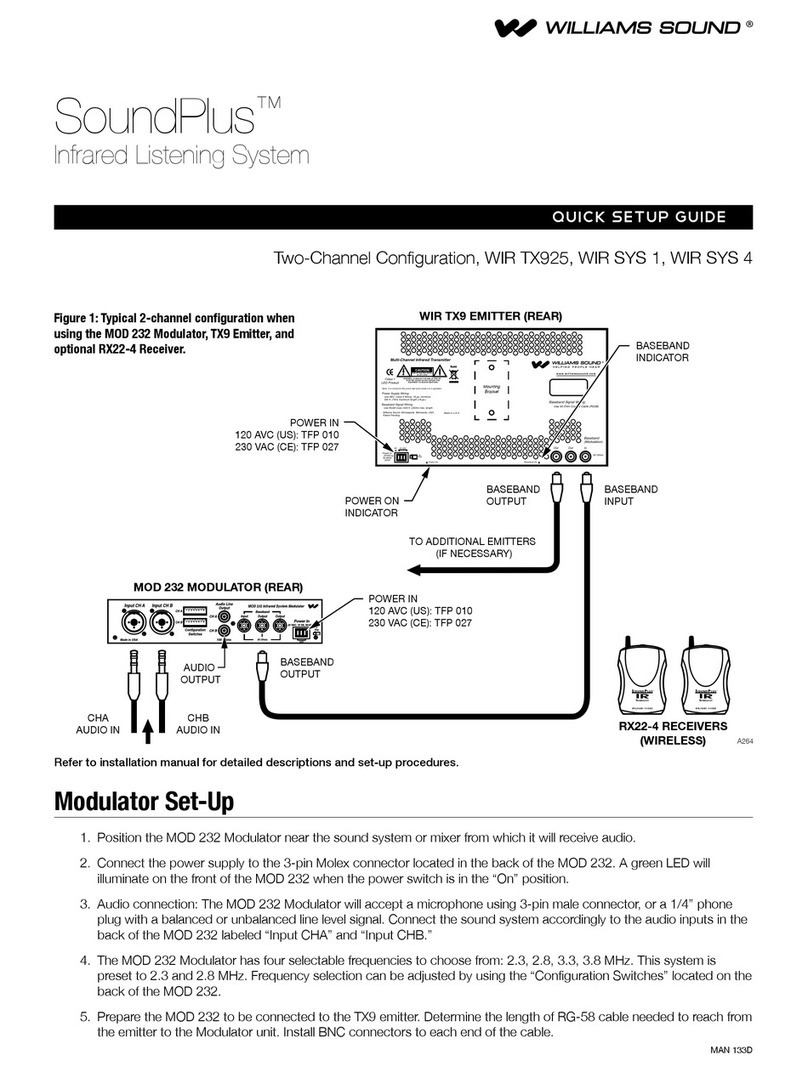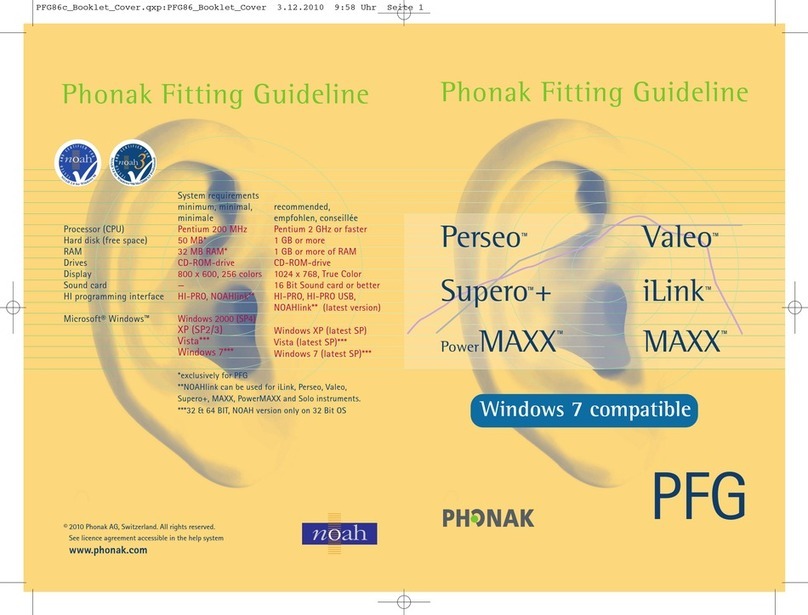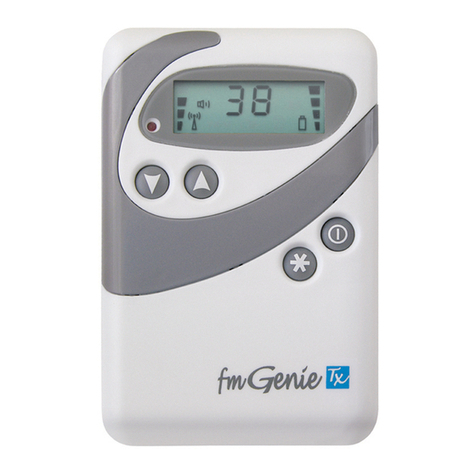HearingDirect HDR200 User manual

Operating instructions
Before use, please read these instructions to help you
get the best out of your HearingDirect.com hearing aid
Model HDR200 / HDR400
Supplied by:
HearingDirect.com
Unit 4 Nine Mile Water
Nether Wallop
Stockbridge
SO20 8DR
UK
NewSound Technology Co. Ltd
1st and 2nd Floor,
No.13 of Xiangyue Road,
Torch Hi-Tech Industrial Development Zone,
Xiang ‘An District,
Xiamen, China

Welcome to your new rechargeable
behind-the-ear hearing instrument.
Please read this user manual carefully before use. This user
manual is for the HDR200 and HDR400 rechargeable hearing
instrument models. All information applies to both models; apart
from the different charging methods and listening memories.
The HDR200 and HDR400 hearing instruments are electronic
devices which amplify sounds from the surrounding environment.
They are primarily geared to help people with mild to moderate
hearing loss.
NB: The manufacturer reserves the right to modify the technical
specifications of the product without prior consultation.
Retention Lock
Dome
Sound Tube
Volume Control
Charging Port (HDR400)
Charging Contact (HDR200)
Memory Switch (Program Button)
Charging Indicator Light
and on/off switch
Features
2 3

Charging the HDR400 is similar to charging a mobile phone.
We recommend that you fully charge the HDR400 before using
it for the first time. A full charge takes about 3 hours, and will provide
up to 20 hours of use. If you need to use the hearing instruments
before the charging cycle is complete, the operation time can be
shorter than usual.
The light green USB cable supplied with the hearing aid has
a micro-USB connector on one side which will fit into the bottom
slot of the hearing aid to charge it.
Charging the
rechargeable
battery
(HDR400 only)
On the other end of the cable is the standard USB connector and
this will plug into the supplied AC power plug connector, a computer
USB port or any other standard USB power source used for charging
other electronic devices.
NB: Please only use the supplied USB cable and adaptor
to charge the HDR400. Other unauthorised cables or adaptors
may damage the instrument.
When the USB cable is connected to a power source, a green
LED will glow near the standard USB end of the cable. If the USB
cable end glows red, please do not charge the hearing aid, contact
Hearing Direct.
When the cable is connected correctly to the HDR400 and charging
begins, the charging indicator light on the HDR400 will glow blue.
It is normal to see this blue light flickering, and to occasionally hear
soft clicks during the charging process.
When the instrument is fully charged the blue LED indicator will turn
green and will be ready to turn on and use.
4 5

The HDR200 charges within the white charger base. We recommend
fully charging the hearing instrument prior to the initial usage. A full
charge takes 2.5-3.5 hours, and will allow for up to 20 hours of use.
If you need to use the hearing instruments before the charging cycle
is complete, the operation time can be shorter than usual.
Connect the micro-USB end of the cable into the charger base,
and the other standard USB side into the AC adaptor, a computer
USB port or any other standard USB power source.
The charger base light will glow green when working normally.
Do not put HDR200 into the charger base if it glows red; contact
Hearing Direct.
Place the HDR200 upright into the charger base. The hearing
instrument can be inserted facing forwards or backwards and
into either the left or right charging holes.
Charging the
rechargeable
battery
(HDR200 only)
When the hearing instrument is placed correctly in the charger the
HDR200 charging indicator light will glow blue to indicate that the
hearing instrument is being charged.
This LED indicator turns green when battery is fully charged and ready
to be turned on for use.
There is no negative effect to the HDR200 remaining in the charger
after being fully charged since the advanced circuitry regulates the
voltage and monitors the instrument charged condition/status.
Top View Side View
6 7

Power is supplied by a lithium polymer battery and should not be
removed, except by an authorised service centre. The recharging
process will automatically shut off when the battery is fully charged.
The device can work for about 20 hours after fully charged under
quiet environments. In loud surroundings, it takes more power for
the hearing instrument to filter out sounds and thus may have a
shorter usage time, but it will not diminish drastically.
The device will be turned off automatically when charging to make
for a faster charging time. It is recommended that you turn off the
hearing instrument when it is not in use to prevent the battery from
discharging totally and to prevent any feedback noise.
To get the maximum use from the internal battery, it is recommended
that the hearing instrument is charged on a daily basis which is
typically overnight.
Rechargeable
battery
information
Battery
caring
There is no harm in leaving the hearing instrument connected to the
power source after it is fully charged, since the advanced circuitry
regulates and monitors this condition.
The built-in battery cannot be removed or replaced by anyone except
an authorised service centre of Hearing Direct. Contact Hearing Direct
for further information and assistance.
Low battery warning
When you hear one short beep it is a signal alerting that battery
is running low/out. The low battery alert will continue intermittently
until battery gets recharged.
8 9

To adjust the volume, rotate the volume control by your fingertip
up and down. The higher number is, the higher sound there will be.
To increase the volume, turn the volume control up. To decrease
the volume, turn the volume control down.
Volume
control
Your hearing instrument may have up to 4 different listening programs.
When the hearing instrument is turned on, it will automatically be
in program 1. Each time you press the memory switch, the hearing
instrument will move to the next program. The sequence is 1, 2, 3
and 4. Your hearing instrument will alert and help you identify which
program you are using. When you select program 1 you will hear one
beep, program 2 will emit two beeps, and so on.
Memory
switch
/program
button
ON and OFF
function
To turn on the hearing instrument – press and hold the program button
on the back of the hearing instrument for at least one second. A green
light will briefly flash. The hearing aid is now on. (Please note the green
light does not remain on when the instrument is on.)
The device is equipped with power-on delay function, so it needs a
few seconds to get started. Once you get used to wearing the hearing
aid you may prefer to only turn it on when the device is on your ear.
To turn off the hearing instrument, press and hold the program button
on the back for at least a second – there will be a brief blue light flash
and then the aid will be off.
Programs HDR200 HDR400
1For indoor quiet environments For quieter environments
2For indoor noisy environments For noisier environments
3For outdoors For music
NB:
The programs in the HDR200 cannot be further altered.
The programs in the HDR400 can be fully adjusted by Hearing
Direct if required, but unless otherwise discussed before shipment,
have been set as per the table.
NB: Before wearing the instrument, make sure that the volume
is not at the maximum (number 4).
10 11

The hearing instrument consists of three basic parts: The hearing
instrument housing, the sound tube, and the dome.
To attach the dome, push the dome completely over the grooves on
the tube to mount it securely. It is recommended practice to check
that the dome is securely mounted on the end of the tubing before
each and every insertion into the ear canal.
The sound tube for the left ear is marked with small blue printing;
the one for the right ear has red printing.
Inserting your
hearing aid
1. Place the hearing instrument over the top of your ear.
2. Hold the tube close to the dome with the thumb and forefinger.
Insert the dome with gentle pressure into your ear canal until the
tube sits flush against the side of the face. The dome should fit
in the ear canal snugly, but not be uncomfortable.
3. Position the retention lock into the outer bowl of the ear above
the ear lobe using your index finger.
12 13

Whistling in hearing instruments is known as feedback.
It is caused by amplified sound leaving the ear; being picked
up again by the microphone and being re-amplified.
The following tips will help reduce the effect of feedback:
•Lower the volume. Keep volume at a lower setting before
inserting the instrument in your ear. Or, you may prefer
to only switch the instrument on when the device is seated
on your ear.
•Change to a larger dome or longer tubing.
•Ensure the ear canal is clear of wax or debris.
•Ensure the tubing/dome are not broken/torn or blocked.
Dealing with
whistling or
feedback
•
Keep the hearing instrument clean and dry.
•
Please use a soft cloth to clean and remove any body oil or
moisture from the shell of the hearing instrument. If the hearing
device is often in a moist environment or subject to a lot of
perspiration it is recommended to put the hearing instruments
that are turned off into a ‘dry aid box’ at least once a week.
Hearing Direct stocks a number of types of dry aid boxes.
•
Do not use water or other fluids to clean the hearing instruments.
•
Always take care in handling the hearing instrument to prevent
it from falling onto any hard surfaces, such as the counter top,
table or floor.
•
Do not leave your hearing instrument in the direct sun or in areas
where the temperature can rise over 60°C / 140°F for extended
periods of time.
Cleaning
14 15

•
Avoid cleaning with any harsh chemicals or strong cleaners.
•
Keep the hearing instruments out of the reach of children and pets.
•
Keep the tubing and dome clear from wax/debris/moisture build up.
•
Use the brush and cleaning wire provided to ensure the dome
opening and tubing are clear. The tubing can be removed from
the top of the hearing aid, and the cleaning wire inserted all the
way through.
•
Never wear another person’s hearing aid. It could permanently
damage/affect your hearing.
•
Avoid direct contact with force (e.g. wrestling or similar sports)
while wearing a hearing instrument.
•
If pain or skin irritation in the ear develops or you experience
excessive accelerated earwax, stop wearing the hearing
instrument and consult your physician.
•
In the unlikely case of the dome being stuck in your ear canal, after
the removal of the sound tube from the ear, it is recommended to
consult a doctor/nurse for safe removal of the dome.
•
Do not drop hearing device onto a hard surface that can
damage the instrument.
Hazard
warnings and
product safety
Cleaning
16 17
The tubing and dome are considered to be replaceable accessories of the hearing
instrument, and are not included in the hearing instrument warranty. On average
domes will need replacing every 2 months and tubings every 6 months.

The warranty period is 12 months from date of purchase. Loss of
the hearing instrument, and any of the following would not fall under
the manufacturer’s warranty: Damage caused by incorrect use or
improper operation. Damage caused by floods, fires, earthquakes,
and any other event described as ‘acts of God’.
Hearing aid
warranty
•
Please do not wear the hearing aid when swimming. Remove
the hearing aid when it is raining, and when showering or bathing.
If hearing aid accidentally falls into the water, do not use a hairdryer
or microwave to dry it. You can dry it with a soft, clean cotton
cloth and put it in a ventilated environment, or in a dry aid kit
for a few days.
•
Do not expose the hearing aid to extreme temperatures or allow
prolonged exposure to sunlight.
•
Do not wear your hearing aids during X-ray, MR scans, CT scans,
short-wave diathermy, or similar radiation treatments.
•
Take off your hearing aids before you go into high electrical fields
or strong magnetic fields and leave your hearing aids outside.
(Such as transformer substation or power stations).
Operating conditions
Temperature: -20°~60° C, -4°F~140°F
Air humidity: ≤85%
Air pressure: 500~ 1100 KPa
Impact on the environment
Proper disposal of electronic products protects the health of people
and the environment. This symbol means the hearing instrument may
not be thrown away as normal daily waste. Hearing instrument should
be disposed of at intended electronic waste/recycle sites.
Hazard
warnings and
product safety
18 19
This manual suits for next models
1
Table of contents
Other HearingDirect Hearing Aid manuals
Popular Hearing Aid manuals by other brands
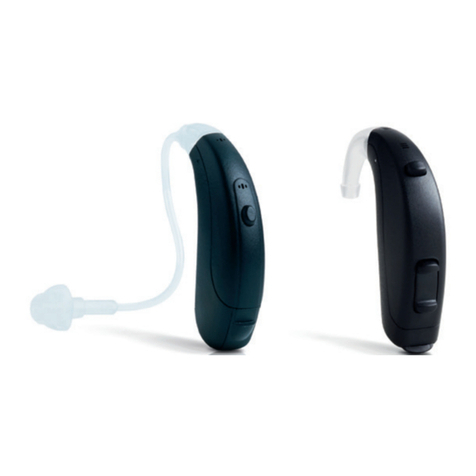
Interton
Interton Crisp user guide
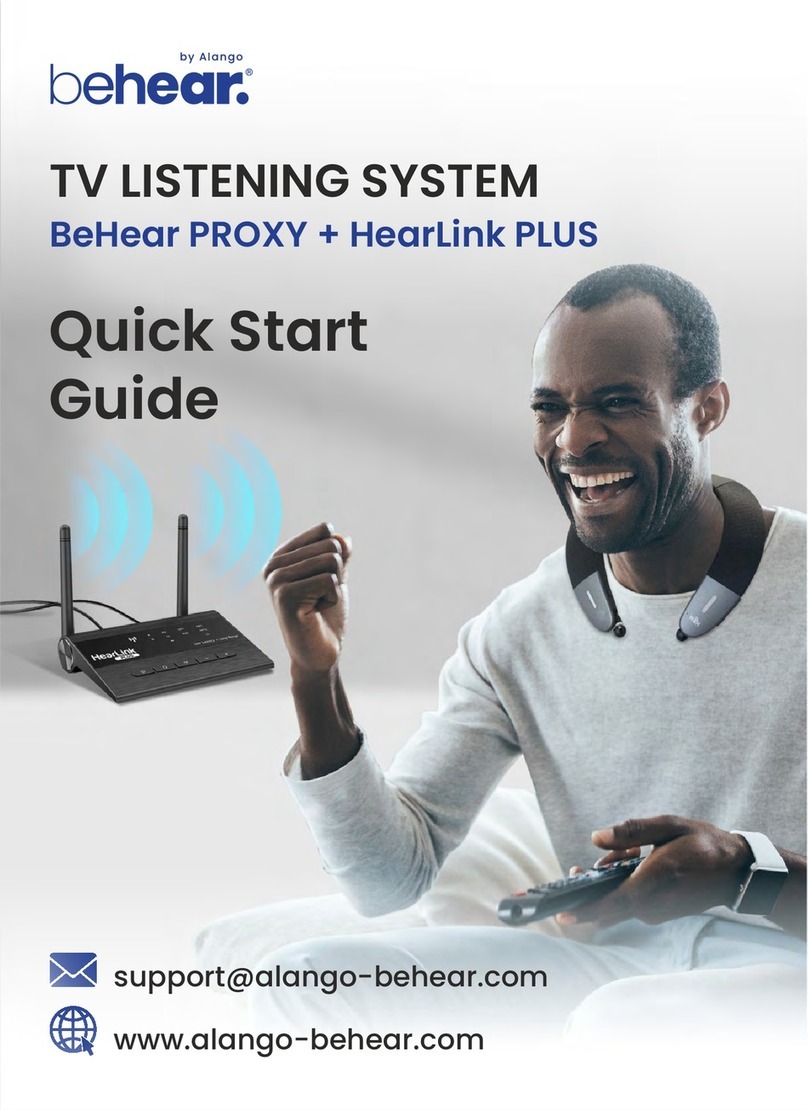
Alango Technologies
Alango Technologies BeHear PROXY quick start guide

Miracle-Ear
Miracle-Ear EarCONNECT 5 SP BTE EV user manual
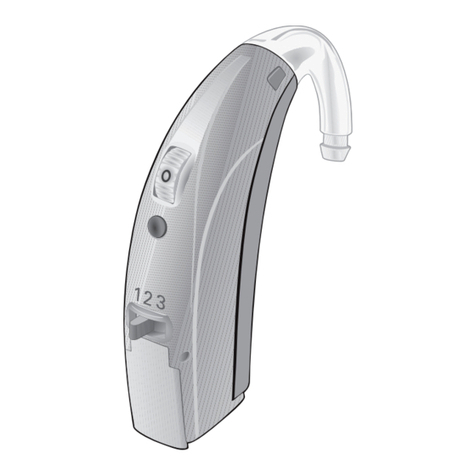
Bernafon
Bernafon XTREME Instructions for use
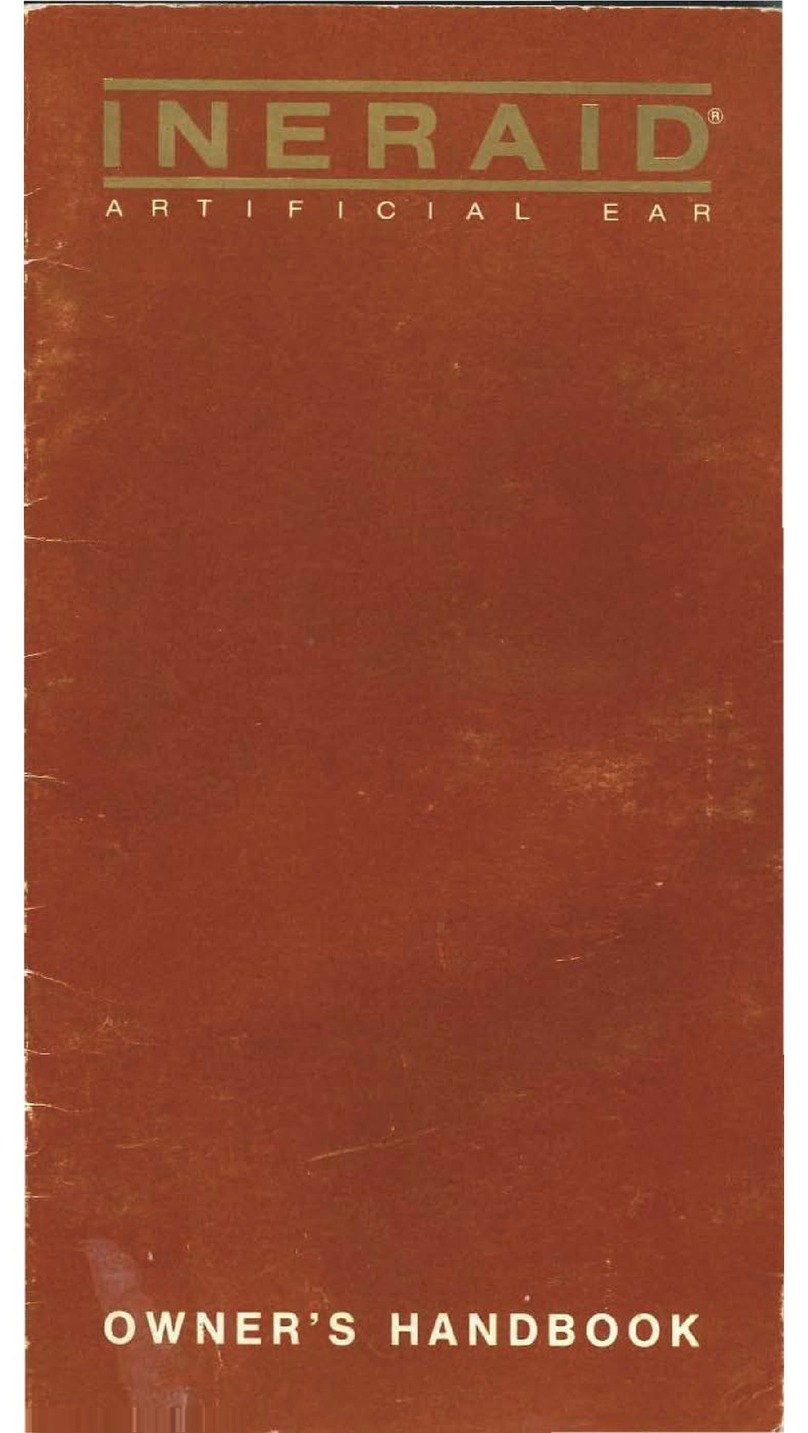
Cochlear
Cochlear INERAID Owner's handbook
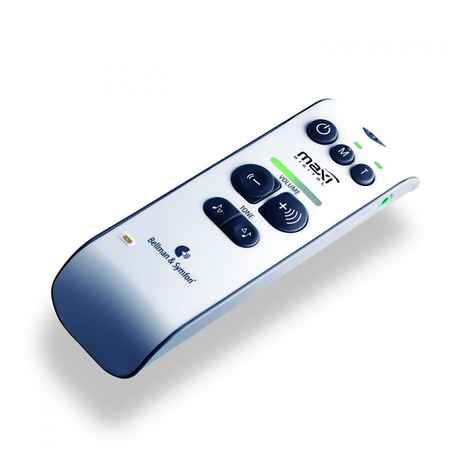
Bellman & Symfon
Bellman & Symfon Audio Maxi BE2020 manual

